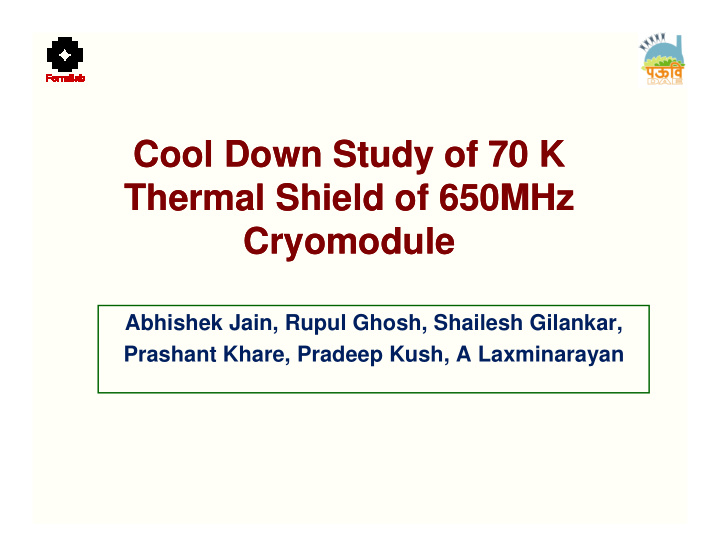



Cool Down Cool Down Study of Study of 70 K 70 K Thermal Shield of Thermal Shield of 650MHz 650MHz Cryomodule Cryomodule Abhishek Jain, Rupul Ghosh, Shailesh Gilankar, Prashant Khare, Pradeep Kush, A Laxminarayan
Outline of talk Part I Part I • Literature survey – Description of 70 K thermal shields for first and Second generation TTF Cryostat • Heat transfer coefficient study and material properties • Queries related to 650 MHz Cryomodule Part II Part II • • – – – – • •
Part I Part I Initial Study and Other Queries Initial Study and Other Queries Initial Study and Other Queries Initial Study and Other Queries
Literature survey There are only few publications since the first TTF cryostat was tested in 1997 A. Cool down simulation for Tesla Test facility (TTF) cryostats B. Design of the thermal shield for the new improved version of Tesla Test facility (TTF) cryostat Both articles were published by D Barni and C Pagani in “ Advances in Both articles were published by D Barni and C Pagani in “ Advances in Cryogenic Engineering”, Vol. 43,(1998) Coupled thermal and structural analysis for both 4K and 70k shield for both first an second generation cryomodules. Actual cool down results have not been discussed or co related with this analysis. There are also certain points that we did not understand in these articles. We do understand that FNAL has cooled the first cryomodule and so the results are available. It would be interesting to see the variation of these results from what is predicted by FEA .
First and second generation TTF Cryostat Thermal shields • First generation TTF cryostat: – Aluminum shields cooled by copper braids connected to stainless steel cooling pipes. The shields themselves were split into parts connected together by hundreds of threaded fasteners. • Second generation TTF cryostat: – The cooling helium pipes are directly welded to the aluminum shields. Upper and Lower parts are connected with “Finger” welding to relieve stresses in the long shield during cooldown.
Difference between Numerical models of TTF 70K Shield First generation TTF cryomodule Second generation TTF Cryomodule Cooling Fast cooldown: Cooling pipe brought Slow cool down: Linear decrease in inlet Scheme immediately to 70 K temperature temperature of helium flowing in the pipe from 300 K to 70 in 40 hours FEA • Shell elements are used •Shell elements are used Assumptions • Surface convective heat load on helium •Helium flowing in the cooling pipe linearly pipe at fixed bulk temperature of 70 K pipe at fixed bulk temperature of 70 K decreasing from the room temp of 300 K to decreasing from the room temp of 300 K to • Thermal radiation only between 300 K & 70 K in 40 hours 70 K surfaces has been considered •In model, fingers are not present ,but it Material used : Aluminum 6082 alloy and considers the real heat transfer section Braids of ETP Copper •Radiation heat exchange between the shields and the surrounding environment is neglected •Material used : Aluminum 1050 alloy
Effect of mass flow rate and pipe dia. on heat transfer coefficient Variation of Heat transfer coefficient and pressure drop with mass flow rate for 2 inch dia. pipe
Temperature dependent material properties Material properties - Temperature dependent: Thermal conductivity, sp. heat, thermal expansion coefficient - Temperature independent properties: density, elastic modulus, poission ratio, surface emissivity Fig. (b) Sp. Heat with temperature Fig (a) Thermal Conductivity with temperature Fig. (c) Thermal Expansion Coefficient with Cryogenic Temperature
Apart from this analysis there is a question related to 650 MHz Cryomodule
- Can we think of connecting the 2K pipe to vent pipe at two locations at two ends ? Perceived benefits: - Required size of 2-phase pipe may reduce and also have enough vapor volume (for emergency venting in a scenario of accidental loss of vacuum). - The 2 K pipe gets totally supported on the HGR pipe and the chimney now becomes just a connection to helium vessel and not a weight carrying member. - No end forces in pipe in case of emergency venting 300 mm pipe Thermal compensator DS end Flange should have a “hard” connection with 300mm pipe
Part II Part II Thermal Analysis Thermal Analysis
Objectives We have studied the cool down simulation of two cryostat i.e. first generation TTF cryostat and second generation TTF cryostat. Now we want to simulate the 650MHz cryomodule’s 70K thermal shield (which has a different size) and see how the cool down would take place. We want to create a platform (step by step), on which we can simulate the cool down of the cryomodule and check if there are some places where undesired displacements or intolerable stresses occur for this cryomodule. This is specially pertinent as this cryomodule has different size and in a way different configuration, (absence of 4k shield).
Thermal Analysis • – – – –
Recommend
More recommend